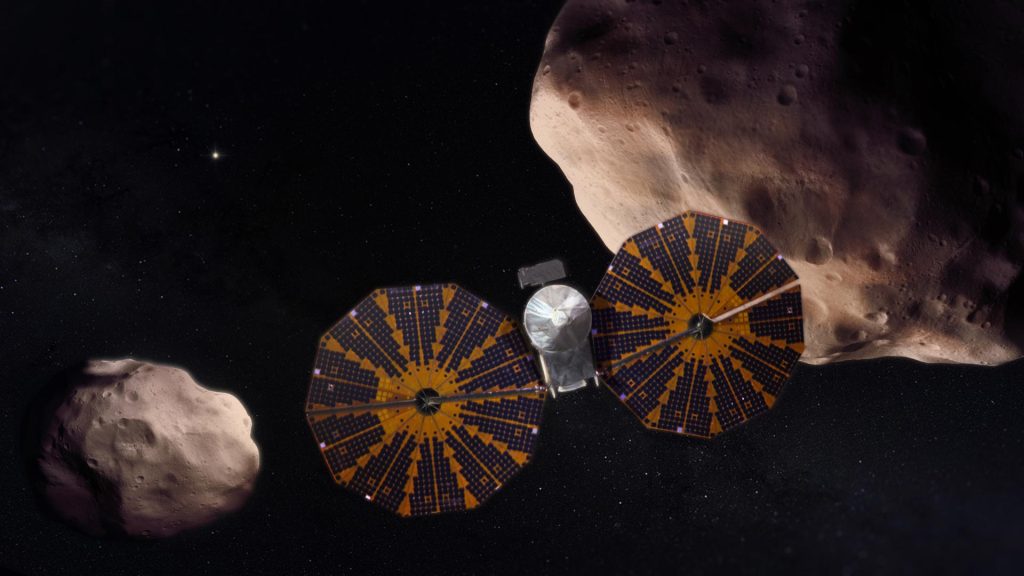

Lucy, Jüpiter’in “gezegen oluşumunun fosilleri” olduğuna inanılan Truva asteroitlerini keşfedecek. Kredi: NASA’nın Goddard Uzay Uçuş Merkezi
ondan önce bile serbest bırakmak Ekim 2021’de,[{” attribute=””>NASA’s Lucy mission was already on course to break records by visiting more asteroids than any previous mission. Now, the mission can add one more asteroid to the list, after a surprise result from a long-running observation campaign.
Lucy’s science team discovered on March 27 that the smallest of the mission’s Trojan asteroid targets, Polymele, has a satellite of its own. On that day, Polymele was expected to pass in front of a star. This would allow the team to observe the star blink out as the asteroid briefly blocked, or occulted, it. The Lucy team planned to measure the location, size, and shape of Polymele with unprecedented precision while it was outlined by the star behind it. To do so, they spread 26 teams of professional and amateur astronomers across the path where the occultation would be visible.

A graphic showing the observed separation of asteroid Polymele from its discovered satellite. Credit: NASA’s Goddard Space Flight Center
These occultation campaigns have been enormously successful in the past, providing valuable information to the mission on its asteroid targets, but this day would hold a special bonus.
We were thrilled that 14 teams reported observing the star blink out as it passed behind the asteroid. However, as we analyzed the data, we saw that two of the observations were not like the others,” said Marc Buie, Lucy occultation science lead at the Southwest Research Institute, which is headquartered in San Antonio. “Those two observers detected an object around 200 km (about 124 miles) away from Polymele. It had to be a satellite.”

A graphic showing the observed separation of asteroid Polymele from its discovered satellite. Credit: NASA’s Goddard Space Flight Center
Using the occultation data, the scientists determined that this satellite is roughly 3 miles (5 km) in diameter, orbiting Polymele, which is itself around 17 miles (27 km) along its widest axis. The observed distance between the two bodies was approximately 125 miles (200 km).
Following planetary naming conventions, the satellite will not be issued an official name until the team can determine its orbit. As the satellite is too close to Polymele to be clearly seen by Earth-based or Earth-orbiting telescopes – without the help of a fortuitously positioned star – that determination will have to wait until Lucy approaches the asteroid in 2027, unless the team gets lucky with future occultation attempts before then.
At the time of the observation, Polymele was 480 million miles (770 million km) from Earth. Those distances are roughly equivalent to finding a quarter on a sidewalk in Los Angeles – while trying to spot it from a skyscraper thousands of miles away in Manhattan.

Using the occultation data, the team assessed that this satellite is roughly 3 miles (5 km) in diameter, orbiting Polymele, which is itself around 17 miles (27 km) along its widest axis. The observed distance between the two bodies was about 125 miles (200 km). Credit: NASA’s Goddard Space Flight Center
Asteroids hold vital clues to deciphering the history of the solar system – perhaps even the origins of life. Solving these mysteries is a high priority for NASA. The Lucy team originally planned to visit one main belt asteroid and six Trojan asteroids, a previously unexplored population of asteroids that lead and follow Jupiter in its orbit around the Sun. In January of 2021, the team used the Hubble Space Telescope to discover that one of the Trojan asteroids, Eurybates, has a small satellite. Now with this new satellite, Lucy is on track to visit nine asteroids on this remarkable 12-year voyage.
“Lucy’s tagline started out: 12 years, seven asteroids, one spacecraft,” said Lucy program scientist Tom Statler at NASA Headquarters in Washington. “We keep having to change the tagline for this mission, but that’s a good problem to have.”
9 Ocak 2020’de Lucy misyonu, yedi değil sekiz asteroidi ziyaret edeceğini resmen açıkladı. Görünüşe göre, Lucy’nin yolu üzerindeki asteroitlerden biri olan Eurybates’in küçük bir uydusu var. Lucy’nin ekibi uyduyu keşfettikten kısa bir süre sonra, o ve Eurybates güneşin arkasına geçerek ekibin onu daha fazla gözlemlemesini engelledi. Ancak, Temmuz 2020’de güneşin arkasından asteroitler ortaya çıktı ve o zamandan beri Lucy’nin ekibi, Hubble ile uyduyu birden çok kez gözlemleyebildi ve ekibin uydunun yörüngesini doğru bir şekilde belirlemesine ve sonunda küçük uydunun erişim kazanmasına izin verdi. Resmi adı – Quetta.
Lucy’nin baş araştırmacısı, San Antonio, Teksas merkezli Güneybatı Araştırma Enstitüsü’nün bir şubesi olan Boulder, Colorado’da çalışıyor. NASA’nın Greenbelt, Maryland’deki Goddard Uzay Uçuş Merkezi, kapsamlı görev yönetimi, sistem mühendisliği, güvenlik ve görev güvencesi sağlar. Littleton, Colorado’daki Lockheed Martin Uzay Şirketi uzay aracını inşa etti. Lucy, NASA’nın Keşif Programındaki on üçüncü görevdir. NASA’nın Alabama, Huntsville’deki Marshall Uzay Uçuş Merkezi, ajansın Washington’daki Bilim Misyonu Müdürlüğü için keşif programını yönetiyor.

“Analist. Tutkulu zombi gurusu. Twitter uygulayıcısı. İnternet fanatiği. Dost pastırma hayranı.”





More Stories
Bilim insanları dünyadaki en büyük demir cevheri yataklarında milyar yıllık bir sırrı keşfetti
Fosillere göre tarih öncesi deniz ineği, timsah ve köpekbalığı tarafından yenildi
Büyük bir bindirme fayı üzerine yapılan yeni araştırma, bir sonraki büyük depremin yakın olabileceğini gösteriyor